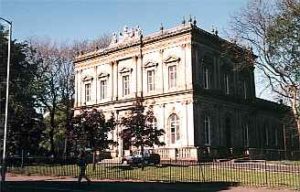 Do you know Langside Hall? Been inside or passed by it a thousand times, but don’t know much about its history? Well it is a rich one at that, and it is said to be a story of architectural excellence and survival!
Do you know Langside Hall? Been inside or passed by it a thousand times, but don’t know much about its history? Well it is a rich one at that, and it is said to be a story of architectural excellence and survival!
It was first constructed on Queen Street in 1847 as the National Bank of Scotland. The beautiful and elegant building was designed by London architect, John Gibson, who stated after his first experience in Glasgow: “I was much gratified by the kindness shown to me in Glasgow, and surprised to see so many public monuments and all by the best sculptors.” (I think we can agree that this would still be said about Glasgow today!)
The building was made even more lavish and astounding in architectural design by London’s John Thomas, who built the House of Parliament, Balmoral, Windsor and Buckingham Palace. Thomas enhanced the building with various sculptures and ornamented the windows with carved keystones representing the major rivers of Britain: Clyde, Thames, Tweed, Severn and Humber. In addition, portal stone vase finials and the Royal Arms supported by a unicorn and lion decorated the roof frontage of the building and the interior boasted a 23-foot diameter coloured stained glass dome, which was provided by Ballantine and Allan of Edinburgh. The walls were decorated with columns and pilasters with a band of black marble framing the floor. The frieze above the columns was adorned with roses, shamrocks and thistles and the floor between telling counters beneath the dome, was paved with coloured marbles which in the centre formed a radiating star.
I’m sure you’re now wondering where this ‘glass dome’ and extravagant interior is now and how Langside Halls is definitely not located on Queen Street. This is where the survival bit of the story begins…In 1896 the National Bank of Scotland were on the hunt for new premises and so the building was purchased in 1898 by Mr Richard Hunter Philanthropist and Chairman of Hunter,Barr & Co Ltd. on the condition that the bank stayed within the premises until 1901. At the same time, the Glasgow Corporation needed to supply a public building for Langside, Battlefield, Shawlands and Mount Florida. Incredibly, the building was moved and rebuilt stone by stone at its current location to be used as a public hall. Unfortunately, however, despite 70,000 of the original stones being used for the rebuild, the interior was re-designed and many of the lavish characteristics were removed to meet more utilitarian needs. Langside Halls as it is seen today was officially opened on the 14th of December 1903 by Councillor William Martin, Councillor W.F Anderson and Baillie Finlay.
This history gives a whole new impression to Langside Halls. The impressive building is a central piece of the community as much today as it was 200 years ago. Despite maintaining much of its original architectural splendour, Langside Halls has not been refurbished in nearly 100 years and as a result does not provide to the community the most it has to offer.
Langside Halls Trust has been established for the sole purpose of working by and for the local community and we aspire for Langside Halls to be a thriving cultural hub for the Shawlands/Langside area. We believe that community ownership of Langside Halls is the best way forward for the historic building to better serve the local people. Currently it is run by Glasgow Life on behalf of the Council. What would you like to see done at Langside Halls? How could it better serve you? We want to hear your thoughts! Please comment below if you have views.







 #b
#b














Let us see this beautiful building from all angles. Make it a pedestrian area. Cut down and make use of the base of the trees for sculpting?